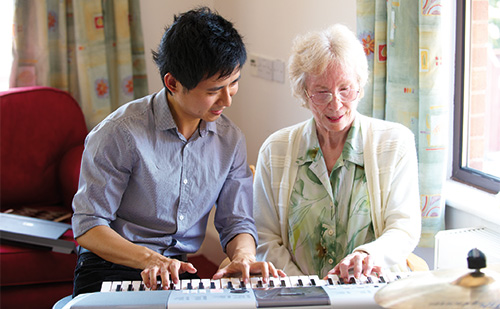- A
- A
- A
Music therapy – reaching the person within

Jan Holdcroft speaks movingly about the way people living with dementia can, as she puts it, struggle to find themselves. She feels that this can account for the repetitious behaviour that some individuals develop – trying to make a connection with who they have been. “It’s painful to see people losing themselves,” she says.
Jan is the manager of Queensway in Stafford, one of the Homes where MHA first piloted the use of music therapy in order to research and carefully record its benefits for at least some of Queensway’s residents. Her experience of watching music therapist Ming Hung Hsu at work in one-to-one sessions convinces her that, where there has been enjoyment of music in the past, its present benefits can be profound. “Ming reaches out to people and they reach back – it’s wonderful to see”, she says – adding, however, that “you need someone to help them engage with it”.
Ming, whose painstaking work with one Queensway resident was described in the Autumn 2009 edition of Heart & Soul, has been using dementia care mapping to demonstrate the way in which music therapy can enhance the well-being of individuals living with the illness. He is delighted that MHA has responded to the results of his work by expanding the delivery of the service across all its Dementia Care Homes, making it one of the very few organisations in the country to use music therapy so widely in a long term care setting.
Its benefits are seen not only in the individuals with whom therapists meet but in the knock-on effect for relatives and carers alike. Ming describes his one-to-one sessions with Jamie*, a gentleman with frontal temporal dementia. One effect of this form of dementia is to make him restless – pacing the rooms for much of the time. It has also diminished his ability to judge the volume at which he is speaking. Mostly, Jamie’s speech is very blunt and loud. In response to this, Ming plays songs for Jamie that are low in his singing register, meaning that he doesn’t have to use much strength or breath to sing. As a result, Jamie sings more quietly and sensitively. “Following a music therapy session, Jamie still speaks quite loudly, but his carers observe that he has become calmer and much more relaxed.”
Similarly, relatives frequently comment that they recognise something of their loved one’s old self in them again after they have sung with Ming or used percussion instruments to respond to his playing. Indeed, staff and residents of Herondale, MHA’s Dementia Care Home in Birmingham, have celebrated not only the Home’s recent refurbishment but also the impact music therapy has made on all their lives by renaming its four wings: Symphony, Harmony, Melody and Rhapsody.
Now the plan is for MHA to employ a full team of therapists. “It’s very exciting,” says Ming. “With a team we can discuss, plan and develop our work across the UK.” Ming has already been joined by three therapists based in London, the Midlands and the Oxford/Swindon area. It is hoped that four more will make up the full complement by the end of the year. In addition, MHA hopes that a new Music Therapy Appeal will help support their work, covering ongoing staff and project costs and allowing the team to purchase additional musical instruments for residents to play.
Jan Holdcroft remembers walking down the hall one day beside a resident who turned to her, pointed towards her own head, and said to Jan, “This isn’t working properly is it?” She paused and then added, “You must promise me you’ll always take care of me.” Jan and Ming, and those who will work as part of MHA’s music therapy team, know from their experience of people like Jamie that music is one way in which they can do just that, helping individuals to reclaim some part of themselves that it seemed had been lost forever.
